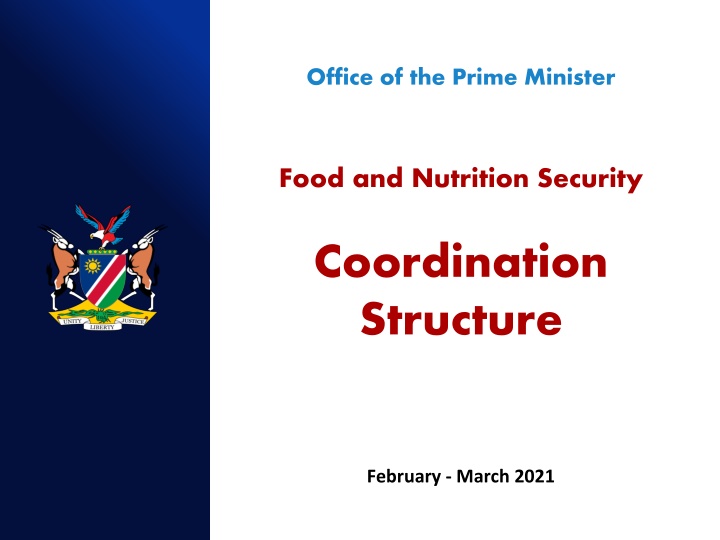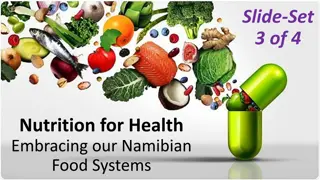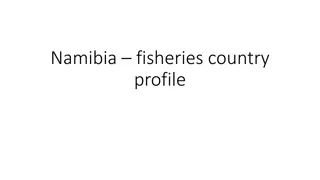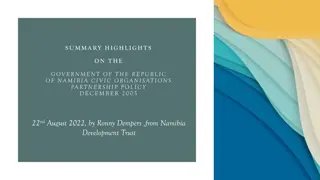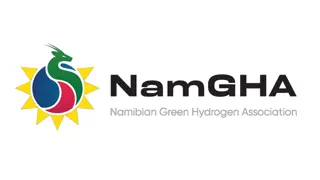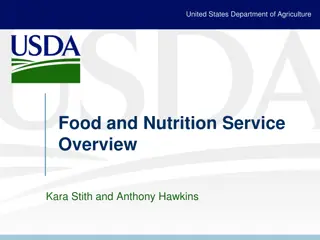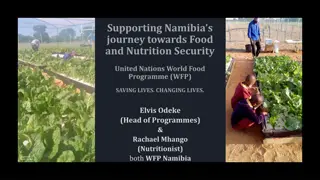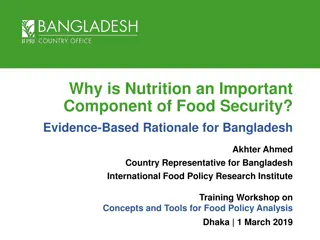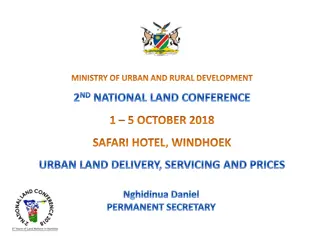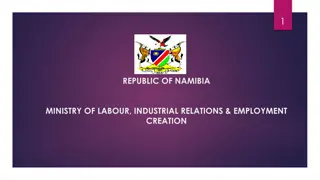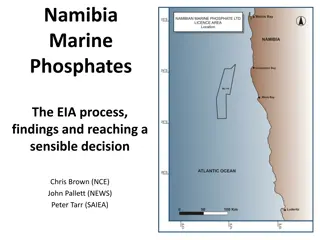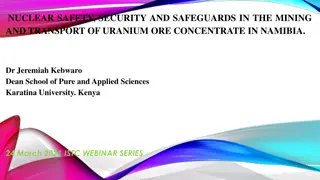Improving Food and Nutrition Security Coordination Structure in Namibia
The document outlines the establishment, evolution, and recent developments in the coordination structure for food and nutrition security in Namibia, with a focus on government commitment, stakeholder involvement, and coordination mechanisms. It highlights the transition from dormant entities to the Nutrition and Food Security Alliance of Namibia (NAFSAN) and the role of various sectors in enhancing nutrition outcomes.
Download Presentation

Please find below an Image/Link to download the presentation.
The content on the website is provided AS IS for your information and personal use only. It may not be sold, licensed, or shared on other websites without obtaining consent from the author.If you encounter any issues during the download, it is possible that the publisher has removed the file from their server.
You are allowed to download the files provided on this website for personal or commercial use, subject to the condition that they are used lawfully. All files are the property of their respective owners.
The content on the website is provided AS IS for your information and personal use only. It may not be sold, licensed, or shared on other websites without obtaining consent from the author.
E N D
Presentation Transcript
Office of the Prime Minister Food and Nutrition Security Coordination Structure February - March 2021
Content of the Coordination structure 1. Foreword by Right Hon. Prime Minister Highlighting government commitment to ensure efficiency and effectiveness in coordinating the implementation of the food and nutrition security interventions. How the four levels of operation will enhance involvement of stakeholders from different sectors in planning and implementing related interventions. 2. Acknowledgement GRN acknowledging the valuable contributions of all role players in developing this document. 3. Abbreviations and Acronyms 4. Executive summary providing: o The background and the rational to revise the coordination structure o The descriptions of the four levels of this Coordination Structure. o Information on how to track progress and improve on gaps. o The effective action government will employ, encouraging stakeholders to take up their rightful roles and responsibilities. 5. Three chapters: 1. Introduction: 2. TORs for all committees (their mandate, membership, roles, meeting schedule) 3. Progress tracking tools 6. Conclusions 7. Annexures: List of contributors 2
Background In September 1994, the Cabinet approved the establishment of a three-tier institutional structure named the Food Security and Nutrition Council (FSNC) at the national level to address food and nutrition security. Chaired by then Permanent Secretary of Ministry of Health and Social Services. Technical Committee was chaired MAWRD. FSNC FSNS GOVERMENT MINISTRIES ( 7) ACADEMIC INSTITUTIONS INTERNATIONAL AGENCIES NGOS CO-OPTED MEMBERS Institutional re-arrangement, led to the division of Rural Development relocated from the then MAWRD to the then MRLG, as a result the Food Security and Nutrition Committee and the entire Council became dormant. In 2010, the National Alliance for Improved Nutrition (NAFIN) was established, yet in recent years became dormant and didn t have the proper convening power. 3
Background Cont OPM approached Cabinet with existing challenges. Cabinet Decision No: 1st/14.02.17/004, resolved that OPM: a) Revive the National Food Security and Nutrition Council to be chaired by the Office of the Prime Minister. b) Endorse the National Alliance for Improved Nutrition (NAFIN) to serve as a technical partner to advocate for nutrition specific interventions. OPM established a committee comprising of relevant OMAs and UN Agencies. In 2019, a participatory process with support from the global SUN ( Scaling Up Nutrition ) Movement lead to a transition out of NAFIN to the establishment of the Nutrition and Food Security Alliance of Namibia (NAFSAN). NAFSAN serves as a coordinating platform for civil society organisations, academia, private sector organisations and committed individuals to improve nutrition in Namibia and support government through coordinated efforts. 4
Background cont. recent development NAFSAN Civil Society + Academia Government + Private Sector + Individuals Civil Society Private Sector Food and Nutrition Security Council (2020) Food and Nutrition Security INTER-AGENCY STEERING COMMITEE + UN Agencies as Institutional Supporters 2010-19 UN/Global Partners Academic Institutions Country Network Members Members Members Members Members Members Members Members Integrated into and aligned with Regional Structures Members Facilitating Dialogues, Networking, Advocacy, Sourcing of additional Funding Integrated into and aligned with Structures at Constituency Level
To strengthen the Institutional structures Rationale for revision of the Coordi- nation Structures and To improve coordinated implementation to overcome all forms of malnutrition and food insecurity at all levels. 6
Implementation and governance of the revised Coordination Structure is founded on the following GUIDING PRINCIPLES: Guiding principles: Coordi- nation structure Effective coordination within and across sectors Community empowerment and effective involvement. Decentralization of adequate tools and resources and governance system for better implementation. Accountability and participation across sectors at national, regional, district and community levels.
The process included: Process of revising the Coordi- nation structure wide consultations with representatives from the Government, partners, academic governmental organizations, private sectors, civil societies and donors. situation analysis through literature review, sector specific group consultations for content reviews. development institutions, non- and individual validation workshops (now!). 8
Food and Nutrition Security Coordination Structures: Other Countries In order to ensure accountability, lessons learned from other countries show that effective coordination of Food and Nutrition Security interventions require: a neutral, strategic and high-level political office with strong convening powers. 9
Food and Nutrition Security Coordination Structures: Other Countries Country Coordinated by: Chaired by / Lead Agency Reference Republic of Zimbabwe National Ministerial Task Force on Food and Nutrition Security Hon. Vice President Policy Implementation structure: Food and Nutrition Security Policy (launched 2013) United Republic of Tanzania High level Steering Committee on Nutrition PS - OPM The Tanzania National Multi-Sectoral Nutrition Action Plan 2016-2021 Kingdom of Lesotho Lesotho Food and Nutrition Council Chaired by Prime Minister Lesotho Multi Sectoral Nutrition Governance Capacity Assessment Report - April 2018 Republic of South Africa National Food and Nutrition Advisory Committee Chaired by Deputy President 24 No.37915 Government Gazette, 22 August 2014 The National Policy on Food and Nutrition Security for SA 10
LEVEL 1 - NATIONAL: Refers to the first and top tier ranking for decision-making in all Food and Nutrition Security Policy implementation directives and emerging concerns. Coordination Structures The national structure comprises of three bodies: 1. The Food and Nutrition Security Council (FNSC): The over-arching body. Provides critical information on food and nutrition to the Cabinet for approval. Chaired by the Right Honourable Prime Minister. (National) 2. Food and Nutrition Inter-Agency Steering Committee: The body that provides coordination, management and implementation of Food and Nutrition Security. It is made up of the Executive Directors from the same ministries and technical experts, chaired by Secretary to Cabinet. This committee addresses all technical issues regarding food and nutrition security in the country. 3. The National Secretariat: Offers all the administrative support to the coordination bodies at the same time link and coordinate the stakeholders. The National Secretariat will work closely with the Sub-National team. Detailed TORs are provided for. 12
Sub-National Structures LEVEL 2 - Regional level: Regional decision-making tier for Food and Nutrition Security program implementation. The Regional Development Coordination Committee is the over-arching supervisory body for the food and nutrition security stakeholders at the region, supervised by Chief Regional Officers. Coordination Structures Level 2, 3 and 4. LEVEL 3 - Constituency level: In this tier decision making is navigated by Regional Councilors through the constituency development committees. Here, technical matters regarding food and nutrition security will be led by community resource persons and agriculture extension workers. LEVEL 4 - Community level: Here decision making is steered through the community leaders, community health workers, community members, and other existing and relevant structure in the community/village. Community health workers will chair the meetings. 13
The functions of Sub-National Secretariat will be the same as of the National Secretariat. Sub- National Secretariat Chief Regional Officers to nominate three staff members under their establishment to serve on the Subnational Secretariat. Sub-National Secretariat to work in close collaboration with National Secretariat 14
The Regional Secretariat (NS): 3 nominated staff from existing structures of Regional Council The functions of the Regional Secretariat: Regional Secretariat o Initiate and participate in committee meetings as scheduled and as outlined in the respective works plans, take minutes and provide feedback; o Provide administrative support and collaborate with respective chairs in convening meetings; o Meet prior to every scheduled meeting either prior to the Council or Steering Committee meetings; o Keep data base of all committee members (name, department, agency and contact details); o Collaborate with the chairs in preparation of agendas for meetings, invitation of participants and circulation of minutes. See more detailed functions from page 12 of the Food and Nutrition Security Coordination Structures. 15
Mandate: Oversee the actualisation of related programs and determine their achievements, suitability and identify gaps. Constituency Development Committee (CDC) The functions of the CDC: o Oversee, monitor and coordinate all stakeholders implementing food and Nutrition security related programs in the constituency, o Identify resources, capacity gaps and challenges experienced by partners when implementing food and nutrition security programs and relay to the Regional FNSTC for action, o In liaison with the CDC, identify communities that are food insecure and share report with RDC, See more detailed functions from page 15 of the Food and Nutrition Security Coordination Structures. 16
Mandate: Collaborate with stakeholders to ensure food and nutrition security issues are addressed through joint planning, training, implementation and evaluation of programs at community level. Village Development Committee (VDC) The functions of the VDC: o Convene and coordinate meetings of all stakeholders on monthly basis, o Actively participate in assessing the food and nutrition situation in the community and report to the CDC, o Identify malnutrition cases and food insecure households and report to CDC, o Identify gaps and challenges facing the communities in implementing food and nutrition security programs at the community level, See more detailed functions from page 16 of the Food and Nutrition Security Coordination Structures. 17
Agricultural Extension and Engineering Services in Namibia exists to promote adoption of improved agricultural technologies and practices in order to increase agricultural production, empower farmers, and facilitate sustainable improvement in living conditions of rural communities. FOOD SECURITY: Main objectives: Provide agricultural extension in the form of communication, advisory and training services to farmers and stakeholders. Provide subsidies agricultural inputs and services to subsistence farmers Contribute to the implementation of an effective drought preparedness planning and responsive drought management system, Establish a mechanism to regulate and manage irrigation on a national basis, Promote technology development, adaptation and adoption, as well as information dissemination in the agricultural sector, Identify and implement technological needs and requirements in the area of agronomy, mechanization, animal husbandry, soil conservation and agricultural structures, Ensure conformity to regulations and policies on plant health and agro-chemicals quality and safety, Improve the legal environment to improve farming production. Government commitment to the sub- national level 18
In addition, it is expected that Community Health Workers should: NUTRITION: Government commitment to the sub- national level play an effective role in bringing much needed public healthcare services closer to the people, and educate community members on health-related matters in addressing all forms of malnutrition. 19
NAFSAN is part of: Scaling Up Nutrition (SUN) Civil Society Network: 3,000+ member organisations in over 50 countries; Collaboration between Government NAFSAN as Civil Society Alliance NAFSAN working closely with GRN: Provide technical guidance and regular feedback on national and sub-national levels; Initiate and support implementation of activities and play a role in monitoring and evaluation; Facilitate dialogue platforms around FNS; Advocate for FNS policies, legislation, research etc. Sensitize and empower communities around FNS; Scale new technologies and other innovations; Mobilise private sector and international donors to invest in food and nutrition security. 20
Office of the Prime Minister (Lead) Line OMAs National Planning Commission, Ministry of Health and Social Services, Ministry of Agriculture, Water and Land Reforms, Ministry of Gender Equality, Poverty Eradication and Social Welfare, Ministry of Education, Arts and Culture, Ministry of Higher Education, Technology and Innovation, Ministry of Urban and Rural Development, Ministry of Industrialisation and Trade, Ministry of Information and Communication Technology, Ministry of Labour, Industrial Relations & Employment Creation, Ministry of Fisheries and Marine resources , and Ministry of Environment, Forestry and Tourism. Regional Councils and Constituency Representatives List of Contributors Development Partners UNICEF, WFP, WHO, FAO, USAID etc. Other coopted partners (Technical support) NAFSAN (Academia, Civil Society, Private Sector and individuals) 21
Get final inputs from Regions through Validation processs OPM will submit the final the Policy, IAP and Coordination structure to Cabinet for approval. Way Launch the Policy, IAP and coordination structure together with the revised Policy and IAP. Forward Government will disseminate final documents (after Cabinet approval) to all stakeholders. Strengthen the working relationship between government and NAFSAN through an MoU that is flexible for amendments on an annual basis. We Thank you. 22
